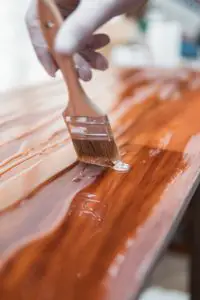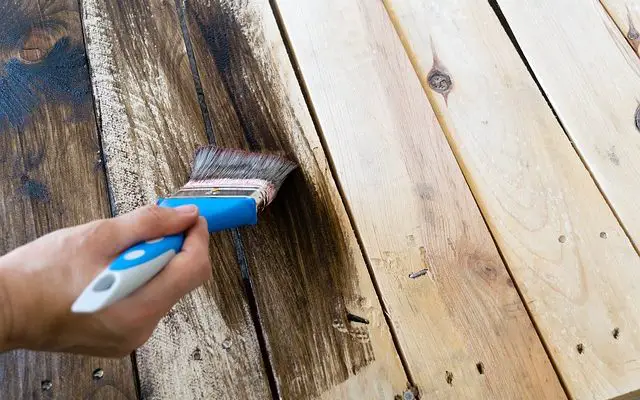Are you trying to work on a project involving wood construction? Things can get tricky, especially when answering the question, “Can I put Wood Conditioner over stain?” Practically speaking, no, you shouldn’t put a wood conditioner over stain. Always use the wood conditioner before applying the stain on the wood. Putting a conditioner over the stain will lift off the stain you applied.
Finishing deals with a lot of techniques. It’s okay if you don’t know too much about how to go about using these processes effectively. Woodwork generally deals with a lot of experience and a reasonably high level of expertise. Besides, there’s a lot to discover regarding the use of wood conditioners. Due to this reason, you’d get to comprehend several crucial details about the use of stain and wood conditioners. Let’s get right into it.
What is a Wood Conditioner?
There are many ways to define the function of a wood conditioner. In simple terms, a wood conditioner is a prestaining step for finishing interior wood before applying a stain. Interior finishing requires a lot of creativity and demands high levels of attention to detail. For this reason, we advise the proper use of a wood conditioner every step of the way.
Understandably, there are diverse brands that deal with the production of wood conditioners. So, it may be a little tasking to choose one. All you need to know is that they are a prestaining step for interior wood finishing. Anything beyond that, especially about the brand, rests on your hands. You may be asking, how do these conditioners work? Let’s move on.
How do Wood Conditioners Work?
It’s easy to understand how wood conditioners function. They work by penetrating the wood to even the absorption rate, which leads to a more uniform stain coat. It’s essential to use them to help make the color of the wood even. If you’re puzzled about what the “rate of absorption means,” there’s no cause for alarm. It implies the rate of oil-based stain integration or other external elements.
No matter what you’re using the Wood Conditioners for, it helps when you know how it works. Understanding the simple working principle makes things better, especially when trying to complete a crucial project. Here’s the thing about comprehending how a product functions; it supports the way you utilize it. You can get more creative on the steps to complete the project.
What’s the Purpose of a Wood Conditioner?
Wood Conditioners are used in treating the surface of the wood. The main function of these conditioners is for the prevention of streaks and blotches. Moreover, it’s meant for the evening out of  oil-based stains. For this reason, you may constantly hear about the importance of using it alongside stain in a specific order. You can use them on specific softwood types because a piece of wood like pine or anyone with several knots present absorbs stain roughly.
oil-based stains. For this reason, you may constantly hear about the importance of using it alongside stain in a specific order. You can use them on specific softwood types because a piece of wood like pine or anyone with several knots present absorbs stain roughly.
The first thing that may race through your mind when you use conditioners and stain wrongly is how bad the piece of wood appears. It may not look completely horrible, but appropriate usage could have made a lot of difference to the piece of wood’s appearance. If you’re wondering, “How does a wood conditioner help even out oil-based stains?” Well, that’s possible by the way it fills up pores. When you use a wood conditioner righty, you will see amazing results on your piece of wood, compared to when you don’t. There’s a high possibility that you’re wondering if you can paint wood conditioners. No need to worry; we’d make the necessary clarifications.
What Is The Best Wood Conditioner?
Surprisingly, there is not a wide selection of wood conditioners available on the market. The two primary manufacturers of wood conditioner are Miniwax and General Finishes. I’ve used both and been happy with the results from each. You can find the Miniwax version at this link (Amazon). The General Finish version can be found here (Amazon).
One thing to keep in mind, the General Finish brand is approximately double the amount of the Miniwax version. Though the prices are near identical, the General Finish comes in a half pint can whereas the Miniwax is a full pint.
Can You Paint Over a Wood Conditioner?
Wood finishing is very delicate. Due to its nature, you need to ensure that you’re taking the right steps. Yes, you can paint over a wood conditioner. However, it would be best if you did it the right way. Ensure that the conditioner has dried for a couple of hours. Advisably, it’s better to wait for the drying process to occur overnight. When the wood is well dried, you may go ahead to apply the paint over it. If you don’t wait for the wood conditioner to dry up, it may lead to your piece of wood getting messed up.
The same principle of painting over a wood conditioner applies to stains as well. However, you need to ensure that you follow some more detailed steps. Painting over a wood conditioner isn’t a bad idea. It makes your piece of wood appear better. Hence, it can improve the look of your interior piece of wood. So, there’s no need to worry. If there’s a need to paint over a wood conditioner, you don’t have to hesitate. We’d go through more details on how you can paint your piece of wood after applying stain over it.
Can You Paint Over Stained Wood?
It’s possible to paint over stained wood. Interestingly, it’s also completely okay to do that. However, you need to understand the steps of painting over stained wood. Start by sanding. What does “sanding” mean? In simple terms, it means smoothing wood with the use of “sandpaper.” Please note that this step is more effective when you’re dealing with a flat surface. With this process, you can roughen the varnish finish and improve how the paint reacts with the piece of wood. How does sanding work?
When painting over stained wood by sanding, you must start by trimming with general-purpose house cleaners. So, you don’t need to shop for any special chemicals or cleaners. Ensure you remove the traces of the residual cleaner by wiping the trim with sponge and water. After doing that, make sure that the trim dries up. Proceed by sanding the trim using sandpaper. Ensure that you do this until it isn’t glossy anymore. Remove sanding dust; you can do this by vacuuming. Apply primers and ensure that they dry up. Go ahead to paint with oil-based or water-based paint. On some occasions, you may mistakenly leave a conditioner on your wood for a long time before painting. We’d see what happens when that occurs later in this writeup.
What Happens If You Leave Wood Conditioner on for too long?
Since wood finishing may be tricky sometimes, there’s every probability to take some steps. One of them is leaving a wood conditioner on for a long time. For this reason, we’d see what happens  when you take this step. If you leave a Wood Conditioner on for too long, there may be some complications. The stain will be unable to penetrate appropriately into the wood pores. Thankfully, this something that can be corrected. You may need to scuff sand with a 230-grit paper. Take that step once you notice that the wood conditioner is already dry.
when you take this step. If you leave a Wood Conditioner on for too long, there may be some complications. The stain will be unable to penetrate appropriately into the wood pores. Thankfully, this something that can be corrected. You may need to scuff sand with a 230-grit paper. Take that step once you notice that the wood conditioner is already dry.
There are time limits to the operation of wood conditioners. Depending on the brand, the limits differ. For some, it only takes 2 hours. Ensure that you confirm this from the support page or by doing some research. Traditionally, it would help if you didn’t wait more than an hour before applying stain or paint on your conditioner. Try ensuring that you apply a stain after the pre-stain conditioner after a short while to avoid going through the process of sanding.
What Can You Do If You Forgot to Apply Wood Conditioner Before Staining?
There’s no cause for alarm. If you forgot to apply a wood conditioner before staining, there are steps you can take to correct that step. You may decide to use a chemical stain stripper to get rid of the applied stain. Although, the best bet to remove the stain is by using an orbital sander. Please note that you shouldn’t apply a wood conditioner after staining. Correcting the mistake doesn’t require you to apply a wood conditioner again. If you’re doing that, it’s simply “medicine after death,” it won’t lead to any great results.
The only reason why it’s advisable to apply chemical strippers is due to the possible effects. If you’re dealing with a curved piece of wood, then these chemicals can be very effective. Although, there’s no point applying them on a flat piece of wood. Instead of doing that, you may use the sanding procedure. Sanding aims to restart the whole process. It may be a little stressful to do this, but it’s one of the most effective correction steps. Ensure that you sand the wood properly. You should take this step before the stain dries up completely.
Conclusion
Wood finishing can be challenging when you don’t understand the way it works. If done improperly, you may end up with a bad result. Interestingly, there are ways to go about without ending up ruining the piece of wood. You may need to understand how wood conditioners work for starters. Later on, you can begin to know the different applications of conditioners for interior wood. Please remember always to use a conditioner before staining. When you do this, it improves the rate of absorption of oil-based stains. Besides, it’s also crucial to avoid leaving your conditioner for as long as two hours. Doing that may end up affecting the stain and messing up your wood project.




